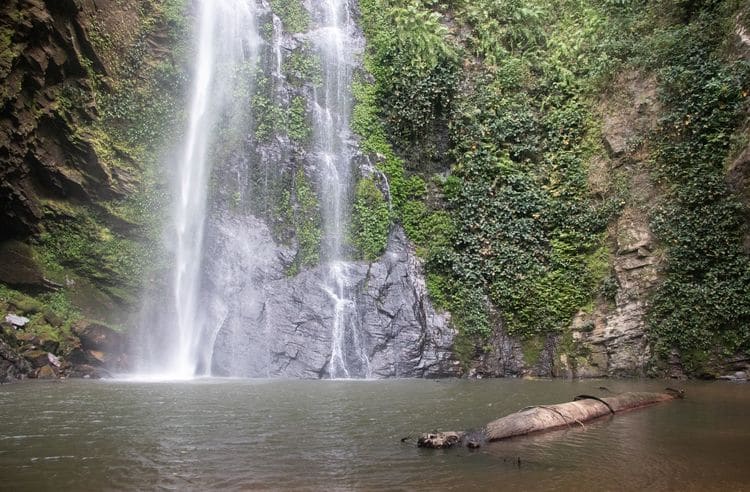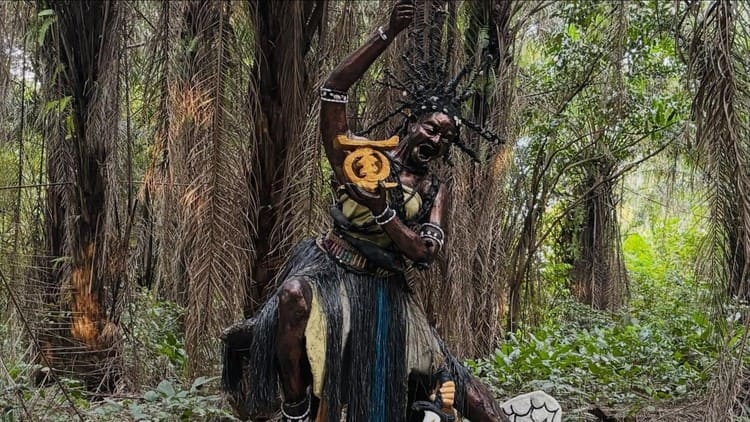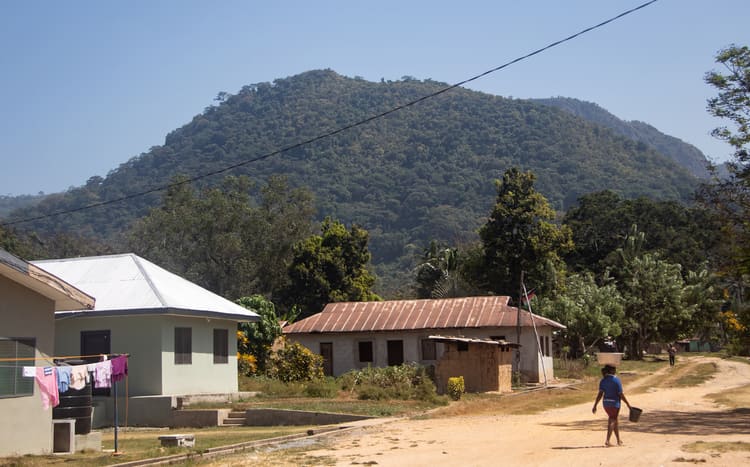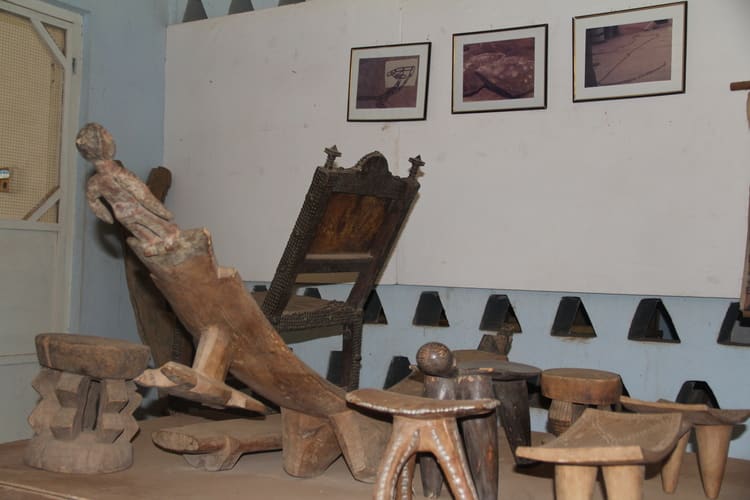Bole Mosque
Bole Mosque offers a fascinating glimpse into the region's rich history and architecture. The mosque's unique Sudano-Sahelian design, the welcoming local culture, and all other nearby attractions such as Mole National Park and Larabanga Mosque will add more unforgettable experiences to your trip.
Tagbo Falls
Tagbo Falls, located in Liati Wote, Ghana, is a 60-meter waterfall surrounded by lush rainforest. It holds cultural significance for the Ewe people and supports the local economy through tourism. Visitors can enjoy hiking, swimming, and cultural experiences.
Asante Traditional Buildings
Asante Traditional Buildings - a collection of unique traditional buildings and Ghana's most sacred spaces. 13 Asante Traditional Buildings that survived colonial destruction and continue serving spiritual communities today. Only one welcomes visitors.
Elmina Castle or St. George Castle
Dive into the captivating history of Elmina Castle, a prominent symbol of Ghana's past. Uncover its dark secrets as a center for the transatlantic slave trade, and marvel at its role in shaping the nation's resilience. From the heartbreaking stories of those who suffered within its walls to the castle's eventual transformation into a beacon of hope, experience the triumph and tragedy that defines Elmina Castle's enduring legacy.
Fort Batenstein
Standing tall on a hilltop in Butre village in Western Ghana, Fort Batenstein offers a mesmerising view of the Atlantic coastline. But it was much more than the spectacular panorama and the paradisiacal beauty of the surroundings that urged Dutch settlers to build this small trading fort in 1656 in this area - GOLD.
The National Museum
The National Museum of Ghana is the country's biggest museum and one of the most visited museums in the West-African sub-region. It contains foreign and local artifacts and collections.
Shai Hills
Uncover the natural wonders of Shai Hills Reserve in Ghana - a captivating destination boasting expansive savannas, forested hills, diverse wildlife, and a tranquil escape into nature's embrace.
Best Markets for a good Shopping Therapy
Explore Ghana's vibrant markets for a unique shopping experience. From Accra's bustling Makola Market to Kumasi's expansive Kejetia Market, each region offers its own charm. Discover fresh produce, traditional crafts, and local delicacies. Whether you're a local or a visitor, these markets provide a glimpse into Ghanaian culture and commerce, making shopping a delightful adventure.
Nzulezu (Nzulezo): The Stilt Village of Ghana
Explore the serene Nzulezu Stilt Village in Ghana. Nestled on Lake Tadane, this unique village offers an insight into a community living harmoniously on water. From its historical roots to its simplistic yet profound daily life, Nzulezu is a magnificent place to visit like no other. Nearby attractions will enrich your adventure, making a trip to Nzulezu a colourful page on your Ghana travel journey.
Boabeng Fiema Monkey Sanctuary
Located in the temperate Brong-Ahafo Region, this conservation forest teems with monkey and bird life, providing a haven for species that are sadly threatened with extinction all over West Africa. The monkeys are considered sacred and the village is charged with protecting these special animals.
Bisa Aberwa Museum
The Bisa Aberwa Museum in Sekondi-Takoradi, Ghana, offers a deep dive into the cultural heritage of the Ahanta and Nzema people. Through artifacts, storytelling, and contemporary art, visitors gain insights into the region's history, traditions, and artistic expressions, making it a must-visit destination for cultural enthusiasts.
Elmina-Java Museum
The Elmina-Java Museum in Elmina, Ghana, stands as a pivotal site of cultural and historical significance. Focusing on the stories and artifacts from the Elmina Castle, a UNESCO World Heritage site, it offers insights into the transatlantic slave trade and Ghana's vibrant cultural tapestry. Through interactive exhibits and diverse displays, visitors can connect with Ghana's rich history, art, and traditions, making it a must-visit destination for those seeking profound cultural experiences.
Fort Apollonia
Explore the unique architecture and history of Fort Apollonia in Western Ghana. Built in the late 1700s, the fort features a strong seaward bastion. After the abolition of the slave trade, the fort was abandoned. However, in the 1960s, it made its return as a museum dedicated to the Nzema culture.
Salaga Slave Market and Heritage Site
An 18th-century slave market located in the Savannah Region of Ghana, played a pivotal role during the Trans-Atlantic slave trade. It served as a crucial market where enslaved Africans were transported to the coast for export.
Kumasi Fort and Military Museum
The Kumasi Fort and Military Museum is situated in Kumasi, the capital city of the Ashanti Region of Ghana. It is one of the few military museums in Africa. Constructed by the Asantehene (the King of the Asante Kingdom) in 1820, the fort was destroyed in 1874 by the British forces and renovated 23 years later. Come and dive into our history!
Kwame Nkrumah Memorial Park
Delve into the fascinating history of Ghana's first president at the Kwame Nkrumah Memorial Park. This beautiful park is a must-visit destination for anyone interested in Ghana's cultural heritage. With its grand mausoleum, beautiful sculptures, and serene surroundings, the park offers an inspiring look at the life and legacy of one of Africa's greatest leaders.
Fort Metal Cross: A Historic Landmark in Ghana
Visit Fort Metal Cross, a historic landmark in Ghana that played a significant role in the transatlantic slave trade. Unveil its dark history and step back in time.
Fort Komenda
Fort Komenda was built in the late 17th century on Ghana's coastline. It played a role in trade and colonial conflicts. The fort was abandoned in the 19th century and is now a UNESCO World Heritage Site. Visitors can explore its ruins and learn about its history and significance.
Kumasi Zoo
Kumasi Zoo is the premier national zoo and located in central Kumasi. Opened to public in 1957, it has become popular attraction among tourists as well as locals.
11,000 hectares is a home to 162 individual animals and 46 different species. Here you will find primates, reptiles, cats, rodents, birds, even hundreds of bats.
International Stingless Bee Centre
Discover the International Stingless Bee Centre in Ghana—a hub of ecological wonders and cultural insights. Dive into the world of unique stingless bees, explore traditional beekeeping, and understand the vital role of these pollinators. A must-visit for eco-adventurers!
Fort Victoria
Fort Victoria was one of a chain of 3 lookout posts built on the hills in the town of Cape Coast around Cape Coast Castle. In 1837 the present Fort Victoria was built on the ruins of its predecessor as a small but strong fort.
Akaa Falls
The Akaa Waterfalls is alluded to as nature's undiscovered magnificence in Ghana. Akaa Falls is a stunning waterfall situated in the Eastern Region. Akaa falls take sources from the Boti waterway, the very stream from which the Boti Falls takes its source.
Zayaa Mud Mosque
South of Bolgatanga in the village of Wulugu stands the Zayaa Mosque. It is made of mud but built in a completely different style than any other mud mosque in the region. It is square with a number of levels and looks more like an ancient defence castle than a place of worship. It was built in the 20th century by Sheik Abdul-Karim.
Paga Crocodile Pond
The Paga Crocodile Pond is natures most impressive wild life site in Ghana. Tourists can get close, can sit, touch, and take photographs with the crocodiles
Bonwire Kente Museum
Explore the Bonwire Kente Museum, a vibrant celebration of Ghana's weaving heritage. Discover the rich history of Kente cloth, its cultural significance, and the artistry behind this iconic African textile. Immerse yourself in a world where tradition weaves the fabric of a nation's identity.
Independence Square in Ghana
This iconic landmark is the symbol of Ghana's relentless pursuit of sovereignty. If you are fascinated by Ghana's history and the triumphs, this is a great place to connect with those moments in history.
Kotokuraba Market
Explore Kotokuraba Market, the bustling heart of Cape Coast, Ghana. This vibrant market offers a wide array of local goods, from fresh produce to handmade crafts. Immerse yourself in the lively atmosphere, interact with friendly vendors, and experience the rich culture of Ghana. Whether you’re shopping for souvenirs or daily essentials, Kotokuraba Market is a must-visit destination.
Cedi Bead Factory
The Cedi Bead Factory in Ghana is a place where you can learn about the history and skill of making beautiful glass beads. Learn more about the craft and the Master Bead maker!
Gyamadudu Museum
Discover Gyamadudu Museum in Kwabre-Heman, Kumasi, a cultural gem preserving Ashanti heritage. Explore artefacts, art, and traditions that connect travellers to Ghana’s rich history while celebrating community and creativity.
Fort William
The trading Fort William was completed by 1757. It was built on hard rock near a sandy beach indentation with a sheltered harbour. The English had built a fort back in 1674 called Fort Charles which was destroyed to prevent it from being captured by other European companies. The English then hurried to construct Fort William.
Fort San Sebastian
Fort San Sebastian in the village of Shama, Ghana, was built in 1526. It played a role in trade and slavery and is now a UNESCO World Heritage Site. Come and explore its history, learn about its past, and understand its importance in Ghana's cultural heritage.
Nakore Ancient Mosque
Visit the Nakore Ancient Mosque, a 17th-century marvel in Ghana's Upper West Region. This mosque, built in the Sudano-Sahelian style, offers a glimpse into the rich Islamic heritage and architectural traditions of the region. Explore its unique design, connect with the local community, and experience the tranquillity of this historical site.
Manhyia Palace Museum
Within the walls of Kumasi lies the jewel of Ghana's cultural crown and one of the most cherished historical landmarks, Manhyia Palace Museum. This museum is a chronicle of Ashanti royalty, where history echoes through halls once walked by kings. It reveals artefacts and wisdom, from the grandeur of royal furnishings to personal effects of the Asantehenes. Have a glimpse at the Ashanti world and feel the pulse of Ghanaian heritage.
Volta Regional Museum
The Volta Regional Museum established in 1973 focuses on ethnographic history of the Ewe People. It exhibits traditional artefacts, Chieftaincy regalia, sculptures and much more.
Boti Falls
Ghana Has Twin Waterfalls That Were Once Lovers (Here's the Story)
Fort Prinzenstein
Fort Prinzenstein in Keta, Volta Region, Ghana is a historic fort with a history dating back to the transatlantic slave trade. The Danish traders built it in 1784 to trade textiles, gold, ivory, and slaves. Visitors can visit the ruins and learn more about fort's role in slavery. It provides a window into a tragic period in human history.
Cape Coast Castle Museum
Want to know how the brave new world came into being? Step back a few centuries and visit the Cape Coast Castle in Ghana. Now a museum, Cape Coast Castle is one of the about 40 slave castles or large trading posts built by European traders and colonists.
National Parks in Ghana you do not want to miss
Ghana is privileged to have some of the most famous and well-known parks in Africa. These unique parks offer amazing landscapes, stunning sceneries, and jaw-dropping natural features. From the famous Kakum National Park, the hippo filled Bui National Park and the gargantuan Mole Park, here is a list of the best national parks in Ghana.
Tetteh Quarshie Cocoa Farm (Ecomuseum of Cocoa)
Tetteh Quarshie Cocoa Farm is where Ghana's chocolate industry began. Walk among century-old cocoa tree plantation, visit research institute, and taste premium cocoa in beautiful Akuapim-Mampong
Fort Amsterdam
Fort Amsterdam, located in Abandze, Ghana, has a long and complex history. Originally built by the British in the 17th century. It wsa destroyed and rebuilt multiple times, before Ghana Museums and Monuments Board restored it in 1951. Today, it stands as a well-preserved piece of Ghana’s past, open to the public for exploration.
Gwollu Defence Wall
The Gwollu Slave Defence Wall, built in the 19th century near the Burkina Faso-Mali border, stands as a symbol of resistance against slave traders. Constructed under the leadership of Sisalla leader Kuoro Tanjia, this 13-foot-tall wall protected the local community. Visitors can explore the wall, the nearby chief’s palace, and other attractions like the Nakore Mosque and Gbele Game Reserve.
Fort Kongenstein
Fort Kongenstein in Ada Foah, Ghana, offers a glimpse into the country's colonial past. Although in a state of ruin, the fort provides visitors with a unique historical experience, scenic views of the Volta River, and an opportunity to engage with the vibrant local culture.
Mole National Park - A Wildlife Adventure in Ghana
Mole National Park is home to one of West Africa's largest populations of elephants and many other endangered species. This premier wildlife destination also boasts a rich cultural history, with evidence of human habitation dating back over 4,000 years. Visitors can explore the park's diverse flora and fauna and immerse themselves in the cultural significance and wilderness of Ghana.
Okomfo Anokye Sword Site
Visit the legendary destination that tells the story of one of Ghana's greatest spiritual leaders. Learn about the history and significance of the Okomfo Anokye Sword, explore the nearby attractions. This is an important and sacred site which also is a big part of Asante history.
Christiansborg Castle
Built by the Danish as Christianborg Castle in the 1660s, Osu Castle has since then been passed on to many different owners. The castle was used for the trade of slaves and gold but was abandoned after the abolition of slave trading in 1803. In 1902 Christiansborg Castle became the seat of government and serves as the office of Ghana's President.
Kintampo Waterfalls
Kintampo Falls is a scenic waterfall with a rich history. Located in the Bono East Region, it features three main drops and a lively atmosphere. Visitors can enjoy swimming, picnicking, and exploring the canopy walkway.
Aburi Botanical Gardens
Discover the enchanting Aburi Botanical Garden in Ghana, a haven of lush greenery and vibrant flora. Immerse yourself in its serene atmosphere, take leisurely strolls along picturesque paths, and learn about the diverse plant species. This article explores the garden's history, highlights its must-see attractions, and provides practical tips for visitors.
Pikworo Slave Camp
Unveil the dark past of Ghana at Pikworo Slave Camp. Explore its haunting history as a slave transit center and auction site, offering a glimpse into the tragic era of the transatlantic slave trade. A must-visit for those seeking to understand the resilience and strength of humanity.
Fort Fredensborg
Fort Fredensborg in Old Ningo, Ghana, was built by the Danish in 1734. It is a historical site with a peaceful atmosphere. The Fort played a significant role in the transatlantic slave trade. Visitors can explore the ruins and learn about its history.
Tanoboase Sacred Grove and Shrine
Visiting the Tanoboase Sacred Grove and Shrine is a unique experience that is both spiritual and educational. The site is located near the village of Tanoboase in the Techiman, Brong Ahafo region of Ghana, and is believed to be the cradle and traditional home of the Bono people.
Sekondi-Takoradi
Welcome to Sekondi-Takoradi, where history meets contemporary Ghanaian life. Sekondi-Takoradi has something for everyone, from its historic landmarks to its festive street carnivals.
Elmina Beach
Elmina Beach in Ghana offers a blend of history, culture, and natural beauty. Located near the historic town of Elmina, it features golden sands and a lively atmosphere. Nearby attractions include Elmina Castle, Fort St. Jago, and Elmina Lagoon. Visitors can enjoy swimming, sunbathing, and exploring historical sites, making it a memorable destination.
Kakum National Park
Join an adventure to Kakum National Park in Ghana. Traverse the canopy walkway, explore the lush rainforest, and the stunning biodiversity. With an abundance of wildlife and flora, this park is a nature lover's paradise. Learn more about practical information and how to get there to start planning your unforgettable journey. Don't miss out on this treasure trove of natural wonders!
Krobo Odumase
Krobo Odumase, a picturesque town in Ghana's Eastern Region, offers travellers a unique opportunity to delve into the region’s history, landscapes, and remarkably beautiful craftsmanship. Fascinating bead-making traditions, breathtaking attractions such as Boti Falls, and welcoming locals, Krobo Odumase is something not to miss when visiting Ghana.
Busua Beach
Busua Beach is a picturesque surfing haven in Ghana’s Western Region. This coastal gem is not just about the tranquil ambiance but a surfing hotspot with the perfect beach vibe. From riding the waves to exploring the nearby historical sites like Fort Apollonia, Busua is a gateway to diverse adventures.
Mount Afadja
Mount Afadja, also known as Afadjato, is Ghana's highest peak at 885 meters. Located in the Volta Region, it holds cultural and spiritual significance for the Ewe people. The mountain attracts tourists with its scenic hiking trails, nearby waterfalls like Wli Falls, and cultural experiences in local villages. It's a symbol of natural beauty and cultural heritage.
Akosombo Dam
The Akosombo Dam is not only a significant landmark in Ghana but also a vital source of hydroelectric power. It is a remarkable engineering marvel. Built-in 1965, it produces electricity for the country and created the largest man-made lake globally.
Larabanga Mosque
Explore the beauty and mystique of Larabanga Mosque, one of the oldest mosques in Ghana. Built in the 15th century, this mud and stick Sudanese style mosque has a rich history and remains a sacred site to this day.
Upper East Regional Museum
Upper East Regional Museum in Bolgatanga, Ghana, preserves the cultural heritage of the Upper East Region. Established in 1972, it features exhibits of local pottery, paintings, musical instruments, and more. The museum offers tours to nearby attractions like Tongo-Tengzuk Hills and Paga Crocodile Pond, making it a key destination for cultural exploration.
Fort Good Hope
Explore Ghana's rich history and heritage at Fort Good Hope, a historic fort that was once used for trade and the transatlantic slave trade. Today, the fort has been restored and is open to visitors, offering guided tours in its rooms and dungeons. Show your support for Ghana's cultural preservation efforts and visit Fort Good Hope.
Tafi-Atome Monkey Sanctuary
Tafi-Atome Monkey Sanctuary in Ghana protects Mona monkeys and promotes ecotourism. Established in 1993, it offers guided tours to see the monkeys and cultural experiences in the village.
Lake Bosumtwe
Nestled in the heart of Ghana's Ashanti Region lies Lake Bosumtwi, a natural wonder steeped in myth and legend. This article takes you on a journey through the history and beauty of this hidden gem, from the mythical origins of its creation to the serene surroundings that you should not miss. Discover nearby attractions and start planning your trip to Lake Bosumtwi today!
Labadi Beach
Discover the perfect mix of adventure and relaxation at Labadi Beach, Ghana's most popular beach destination. From surfing and water sports to vibrant cultural festivals and beachside dining, Labadi Beach offers endless fun and entertainment. Immerse yourself in Ghanaian culture and experience the ultimate beach adventure at Labadi Beach.
Banda Nkwanta Mosque
Nestled in Ghana's Savannah region, the Banda Nkwanta Mosque is an 18th-century architectural sample of Sudano-Sahelian design, built by Sudanese Muslim migrants.The rich history makes it a significant cultural landmark worth visiting.
Wli Waterfalls Travel Guide
Satisfy the adventurous soul inside you while pleasing your sense of aesthetic? Experience Ghana’s nature at its finest and visit Wli Waterfalls!
Fort St. Jago
Discover Fort St. Jago in Elmina, Ghana! Built in 1660, this historic fort offers stunning views and rich stories. From Dutch origins to local legend Kwame the storyteller, it's a must-visit for history buffs. Learn about colonial times and African resilience. Experience centuries of culture atop Elmina's hill. Plan your visit today!


































































